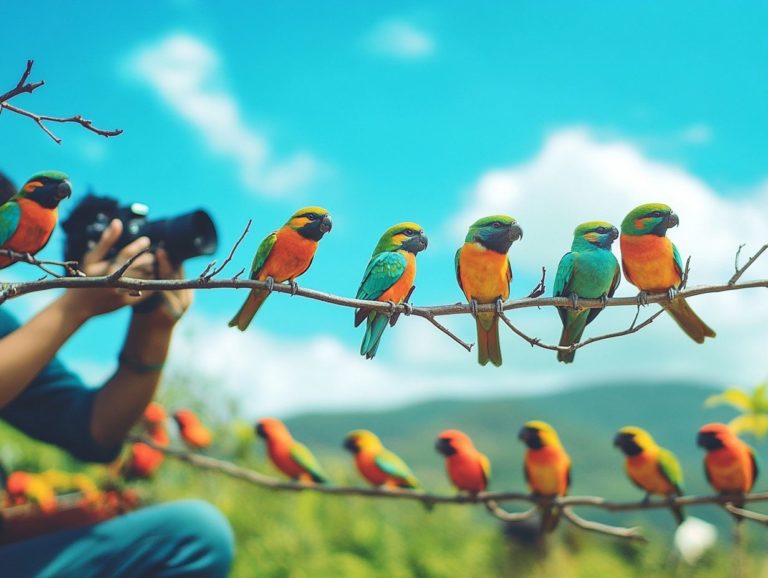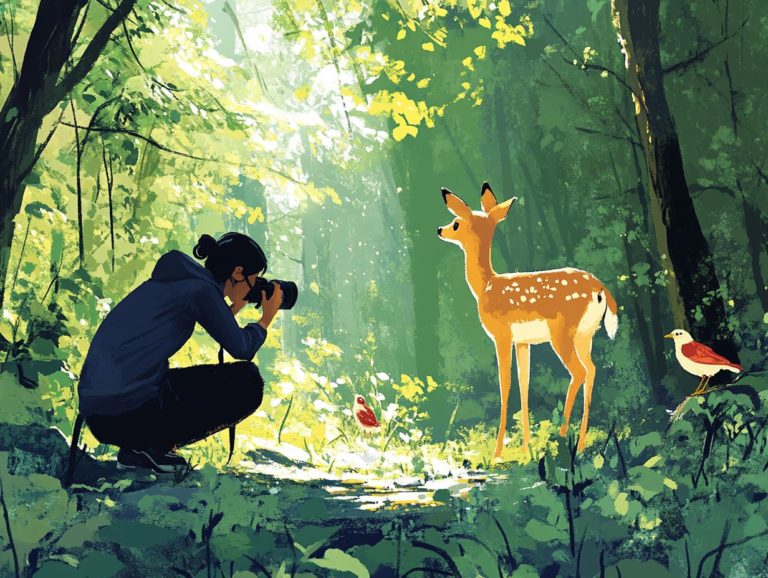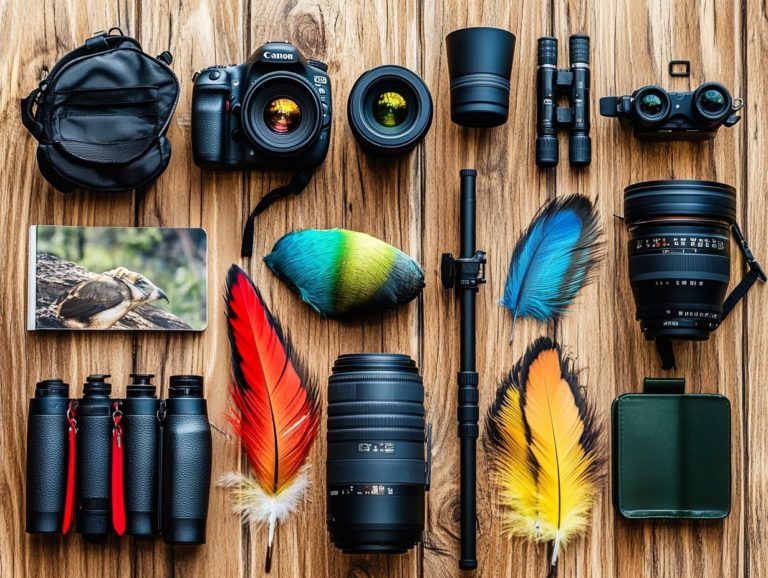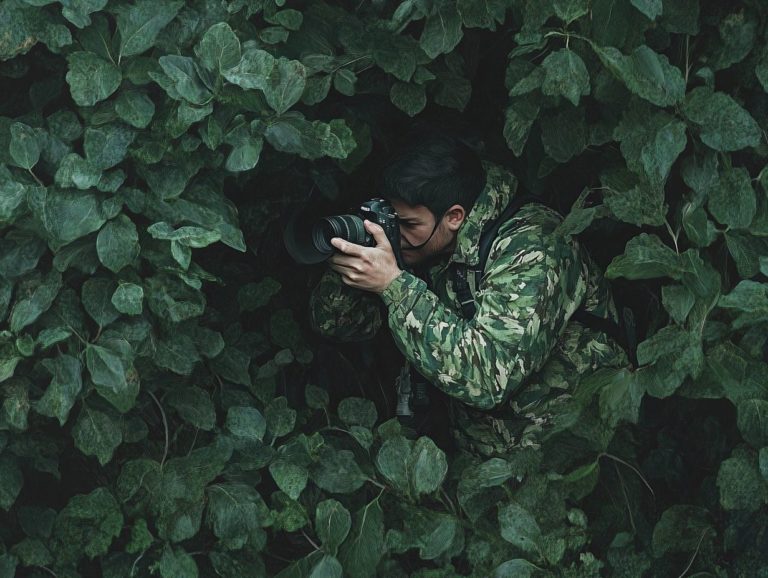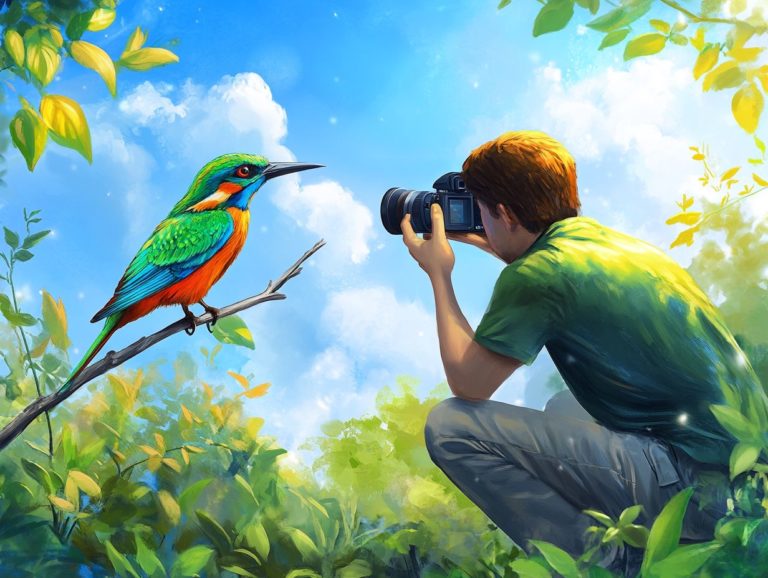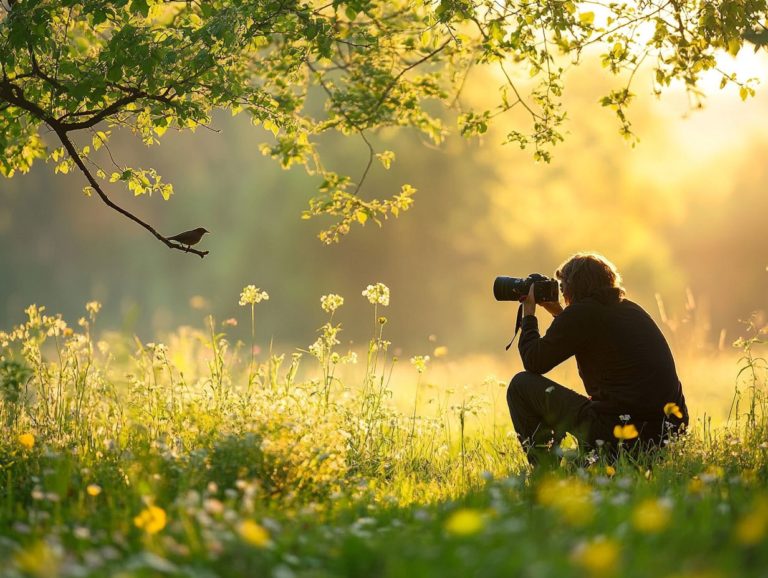Techniques for Photographing Birds in Flight
Bird photography is a mesmerizing fusion of art and science, inviting you to capture the elegance and charm of avian life.
This guide will equip you with essential techniques, from choosing the right gear to understanding bird behavior, all while perfecting your shots in flight.
Uncover invaluable insights on composition and lighting. Embrace the power of patience in your pursuit!
Delve into post-processing methods that can elevate your images, ensuring your bird photography truly stands out. Prepare to enhance your skills and proudly showcase your passion for these magnificent creatures!
Contents
- Key Takeaways:
- Preparing for Bird Photography
- Techniques for Photographing Birds in Flight
- Tips for Capturing the Perfect Shot
- Post-Processing for Bird Photography
- Frequently Asked Questions
- What are some important techniques for photographing birds in flight?
- How can I capture sharp images of birds in flight?
- What is the best time of day to photograph birds in flight?
- What type of camera and lens is best for photographing birds in flight?
- How can I improve my composition when photographing birds in flight?
- What are some common mistakes to avoid when photographing birds in flight?
Key Takeaways:
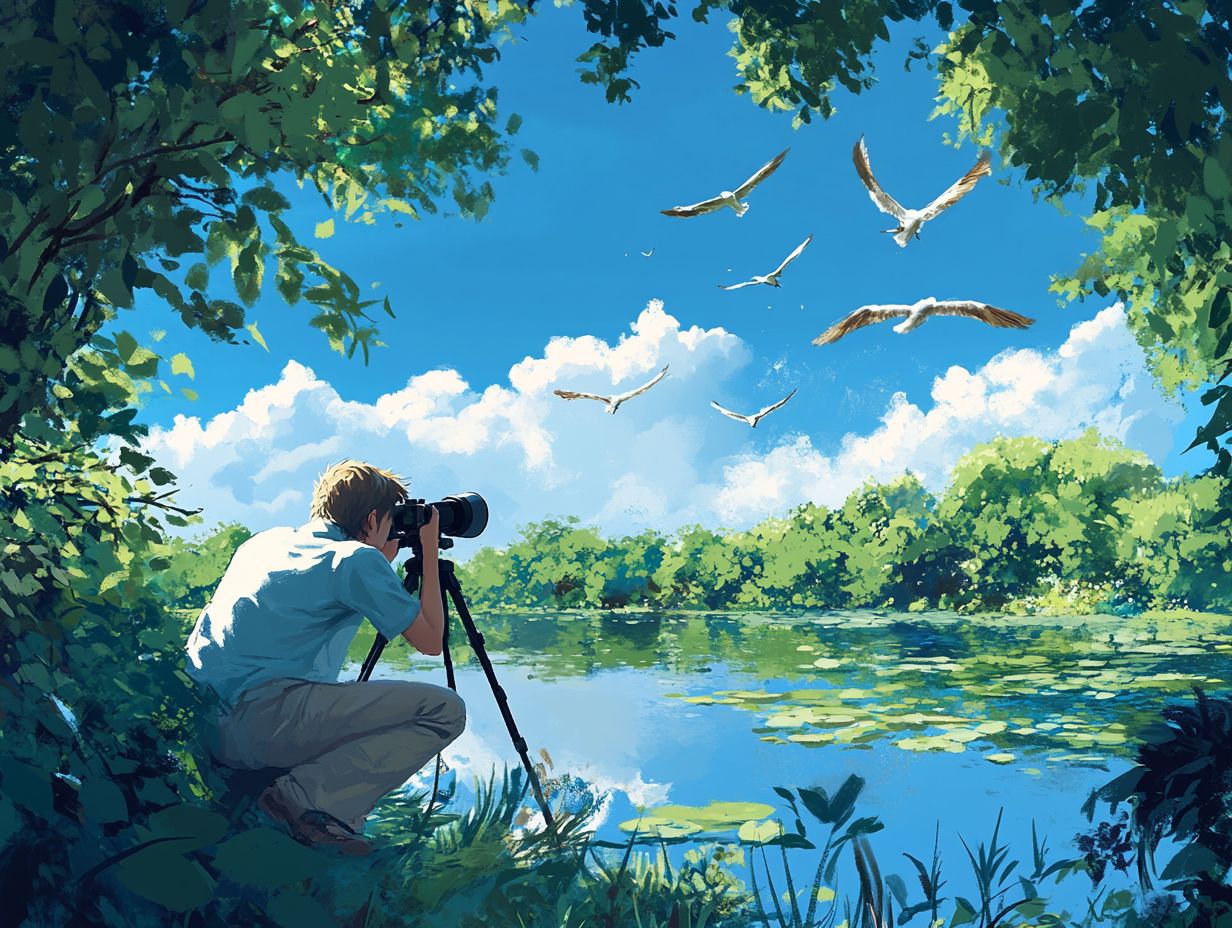
- Choose the right equipment and understand bird behavior to prepare for successful bird photography.
- Master camera settings and tracking techniques to capture stunning photos of birds in flight.
- Focus on composition, lighting, patience, and persistence to capture the perfect shot and enhance your work with post-processing.
Overview of Bird Photography Techniques
Bird photography requires a deep understanding of various techniques designed to capture birds in flight or at rest. From selecting the perfect camera settings to mastering panning techniques, your success hinges on your ability to anticipate bird behavior and react with quick reflexes. A solid grasp of understanding exposure for bird photography can significantly enhance your results.
Mastering camera settings allows you to adapt to changing light conditions, ensuring each shot highlights the intricate details of feathers and their vibrant hues. Regular practice sharpens your skills and helps you develop an instinct for timing the perfect shot.
Finding prime shooting locations, such as wetlands or forests, can significantly boost your chances of encountering a diverse range of species.
Approaching birds quietly without disturbing them is crucial. Employing patience and remaining still can yield breathtaking results capturing the grace of these magnificent creatures in their natural habitat.
Preparing for Bird Photography
Preparing for bird photography involves careful planning, especially in choosing the right equipment and understanding the habits of different bird species. This preparation enhances your chances of capturing breathtaking images, whether you re photographing waterfowl gliding across a tranquil lake or majestic raptors soaring through the sky.
Familiarizing yourself with your gear everything from telephoto lenses to tripods and gimbals is vital for ensuring stability and clarity in your shots. Understanding bird behavior helps you choose the best shooting locations and optimal times for capturing those perfect moments.
Choosing the Right Equipment
Choosing the right equipment is crucial for success in bird photography. The right tools can make a significant difference when capturing those fast-moving subjects mid-flight. A quality telephoto lens is essential for getting close to birds without disrupting their natural behavior. Pair it with a sturdy tripod or gimbal head for the stability needed during lengthy shooting sessions.
Understanding your camera settings especially autofocus and image stabilization enhances image quality and allows you to adapt seamlessly to varying lighting conditions.
When selecting a telephoto lens, consider that prime lenses with longer focal lengths generally offer superior image quality, while zoom lenses provide versatility for different compositions. Your choice often depends on the specific species you wish to photograph and their natural habitats.
A gimbal head can be particularly advantageous with larger lenses. It stabilizes your camera, allowing for smooth panning and tilting without causing fatigue. Balancing your setup between the lens and camera body is essential for comfort during extended shoots.
By adjusting settings like shutter speed to freeze motion and using burst modes, you can significantly enhance your results, especially when your subjects are in full flight or on the move.
Grab your camera and start practicing your bird photography skills today!
Understanding Bird Behavior
Understanding bird behavior elevates your bird photography. You can predict movements and capture stunning action shots. Each species showcases unique behaviors based on feeding, flying, and nesting habits. Paying attention to these details profoundly enhances your photography journey.
Embrace patience and observe keenly in the field. You ll uncover how birds interact with their surroundings, enabling you to wait for that perfect moment to capture a breathtaking shot.
Raptors soar high, making wide circles to scout for prey. Hummingbirds dart rapidly as they hover near flowers. Recognizing these patterns helps you find the right angles and guides your choice of equipment and camera settings.
Document these behaviors with field notes or apps. Track your sightings and get to know the local species. Ultimately, mastering bird photography hinges on continuously practicing observation. With each outing, your patience will yield richer rewards as you refine your skills and capture the mesmerizing dynamics of avian life.
Techniques for Photographing Birds in Flight
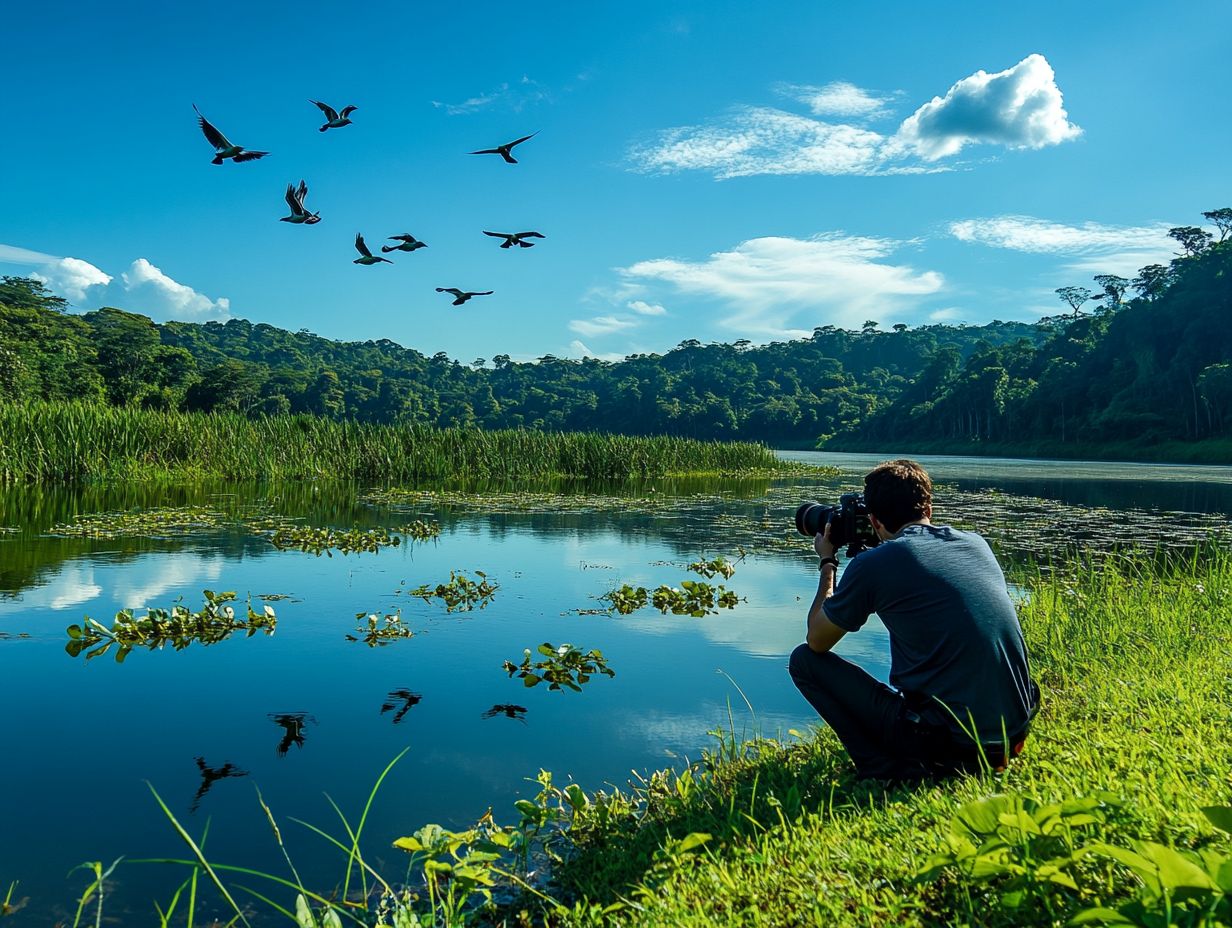
Photographing birds in flight brings specific challenges that demand both technical skills and a keen understanding of avian behavior. To capture sharp images of these swift subjects, rely on high shutter speeds and advanced autofocus systems. For more insights, explore the best bird photography techniques for 2024, which help track focus as birds glide through the air.
Mastering the art of panning infuses your images with a dynamic quality. This technique conveys a sense of motion while keeping the subject in sharp focus. By selecting the right camera settings, you ll be well-equipped to seize breathtaking action shots, ensuring your photography stands out.
Camera Settings and Techniques
Setting up your camera correctly is essential for capturing stunning images of birds in flight. Achieving optimal exposure and focus can be challenging amid ever-changing conditions. To enhance your skills, consider learning about the basics of bird photography composition. Use a high shutter speed to freeze the action and adjust your ISO to maintain clarity in varying lighting environments.
Select the right autofocus mode and understand depth of field, which refers to how much of the scene is in focus. These adjustments elevate your ability to capture striking images of birds as they navigate their habitats.
For example, use a shutter speed of 1/2000th of a second or faster to freeze a hummingbird mid-flight. A slightly slower speed, like 1/1000th, might work for larger birds such as ducks. In low light conditions, like the enchanting hours of dawn or dusk, opt for a higher ISO setting, typically between 800 and 3200, to avoid too much noise.
A wider aperture creates a shallow depth of field, blurring distracting backgrounds and allowing the bird to take center stage. This thoughtful combination of settings transforms an ordinary moment into a breathtaking tableau of nature, capturing the essence of avian grace in all its glory.
Tracking and Capturing Birds in Flight
Tracking and capturing birds in flight requires a blend of skill, practice, and the right equipment, including tips for photographing birds in bad weather, to secure that perfect shot.
By utilizing fast autofocus systems, you can keep the focus points glued to your subject as it zips around. This makes it much easier to capture sharp images that truly highlight the beauty of avian flight.
Integrating the technique of moving your camera smoothly to follow a bird into your shooting repertoire allows you to create dramatic images that depict motion while keeping the birds in crisp focus.
Regular practice will sharpen your reflexes and elevate your success rate in seizing those dynamic action shots.
If you want to take your bird photography to the next level, mastering autofocus settings is essential. Switching to continuous autofocus or AI Servo mode enables your camera to adeptly track your moving subject.
Pair this with a fast shutter speed, and you ll be primed to freeze those fleeting moments in time.
When panning, it’s important to maintain a smooth motion by moving your camera in harmony with the bird’s flight path for optimal effect.
By consistently honing these techniques, you’ll cultivate the vital reflexes that transform each outing into a chance for breathtaking photography.
Tips for Capturing the Perfect Shot
Capturing the perfect shot in bird photography relies on a harmonious blend of artistic composition, an insightful understanding of lighting conditions, and a generous dose of patience.
Effective composition is crucial; it allows you to highlight your subject against a clean background, directing the viewer’s gaze straight to the bird.
Being aware of lighting conditions is crucial, especially during the golden hours of sunrise and sunset. This can significantly enhance the aesthetic quality of your images, turning an ordinary shot into a mesmerizing work of art.
Remember, patience in the field is not just a virtue; it’s essential. Waiting for that perfect moment can lead to breathtaking results that make the effort worthwhile.
Composition and Lighting
Achieving striking composition and mastering lighting conditions are essential elements of successful bird photography. They significantly influence the impact of your images.
By paying close attention to the background, you can enhance your subject and eliminate distractions.
Capturing your shots during the golden hour creates an enchanting atmosphere that highlights the intricate details of birds.
Composing your images using techniques like the rule of thirds or leading lines can effectively guide the viewer s eye and emphasize the bird’s natural beauty within its environment.
When you employ the rule of thirds, you divide the frame into a grid of nine equal parts, positioning your subject along these lines or at their intersections. This technique establishes balance and injects a dynamic quality into your image.
Be aware that variations in lighting throughout the day can drastically alter the mood of your photographs.
Soft morning light often lends a gentle, dreamy effect, while the harsh midday sun can create stark shadows.
Understanding the optimal times for shooting like during dawn or dusk will help you maximize the visual appeal of your subjects. This strikes the perfect balance between exposure and contrast for clearer, more vibrant images.
Patience and Persistence
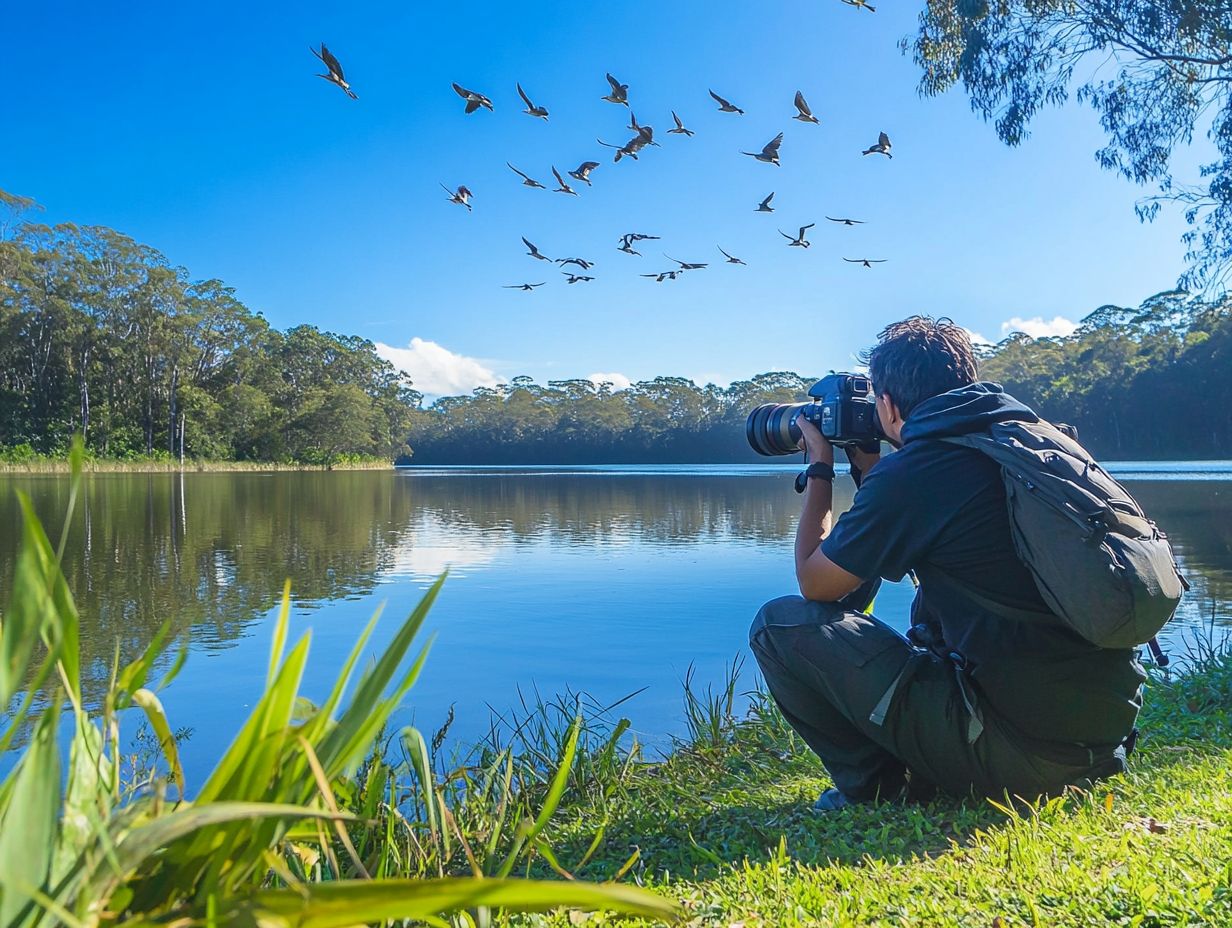
Patience and persistence are your secret weapons in bird photography, essential for capturing those action shots that resonate. Birds can be unpredictable, and understanding their behavior requires time spent observing them in their natural habitat.
By embracing patience, you can wait for that perfect moment when a bird takes flight or showcases unique behaviors. This results in dynamic and compelling images. Consistent practice in the field sharpens your skills while deepening your connection with wildlife.
Consider a photographer who recalls a still moment spent in a quiet marsh, realizing that sitting for hours without moving often leads to unexpected rewards. After that patient wait, they captured the mesmerizing sight of a heron diving for fish an image that spoke volumes about the beauty of nature s rhythms.
This commitment to understanding not only the birds’ movements but also their environments helps you anticipate behaviors and refine your techniques.
The more time you invest in diverse settings, like wetlands or dense forests, the clearer the patterns of avian life become. This ultimately brings you closer to those breathtaking, impactful photographs that tell their own stories.
Post-Processing for Bird Photography
Post-processing is an essential step in bird photography, enabling you to elevate your work from good to breathtaking visual narratives. By harnessing editing software, which helps improve photos, you can fine-tune exposure, color balance, and sharpness, revealing the vibrant hues and intricate details of your subjects.
Adding final touches, such as thoughtful cropping and effective noise reduction techniques, can further refine your images, ensuring they capture attention and shine in your portfolio or during presentations.
Editing and Enhancing Images
Editing and enhancing your images is an essential step in the bird photography journey, allowing you to refine your work and showcase your best shots. By utilizing editing software, you can adjust exposure for optimal brightness, correct colors to mirror reality, and sharpen details to ensure clarity in every facet of the image. These enhancements not only elevate the overall visual appeal but also capture the essence of the bird and its environment in vivid detail.
With specific editing techniques at your disposal, you can dramatically transform a photograph into a stunning visual narrative. For example, adjusting the contrast can make a bird’s feathers stand out beautifully against a blurred background, while boosting saturation can highlight the vibrant colors typical of certain species.
Programs like Adobe Lightroom and Photoshop are particularly favored among wildlife photographers for their extensive features, including user-friendly sliders for exposure and clarity adjustments. The selective adjustment tools in these applications allow you to make targeted edits, helping you showcase the bird while preserving the integrity of the surrounding elements in the photograph.
Sharing and Showcasing Your Work
Sharing and showcasing your work is crucial in bird photography, allowing you to connect with fellow enthusiasts while gaining recognition for your talent. Building a portfolio that highlights your best images serves as a powerful tool to attract potential clients or collaborators.
By utilizing social media platforms, you can broaden your audience and create a space to share tips, engage with other bird photographers, and promote your photography to a wider community.
Creating a compelling portfolio goes beyond simply displaying your best photos; it s about telling a story and reflecting your unique style. Focus on curating a diverse selection that showcases your technical skills and creativity, all while considering the interests of your target audience.
In terms of social media, leveraging visually-driven platforms like Instagram or Pinterest can significantly amplify your reach. By posting regularly and engaging with your followers through comments and direct messages, you foster a sense of community that encourages loyal support.
Using relevant hashtags and participating in online challenges can further enhance your visibility, inviting more opportunities for collaboration and inspiration.
Frequently Asked Questions
In summary, patience, post-processing, and the sharing of your work are vital components of bird photography. Embrace these elements to enhance your skills and connect with the photography community.
What are some important techniques for photographing birds in flight?
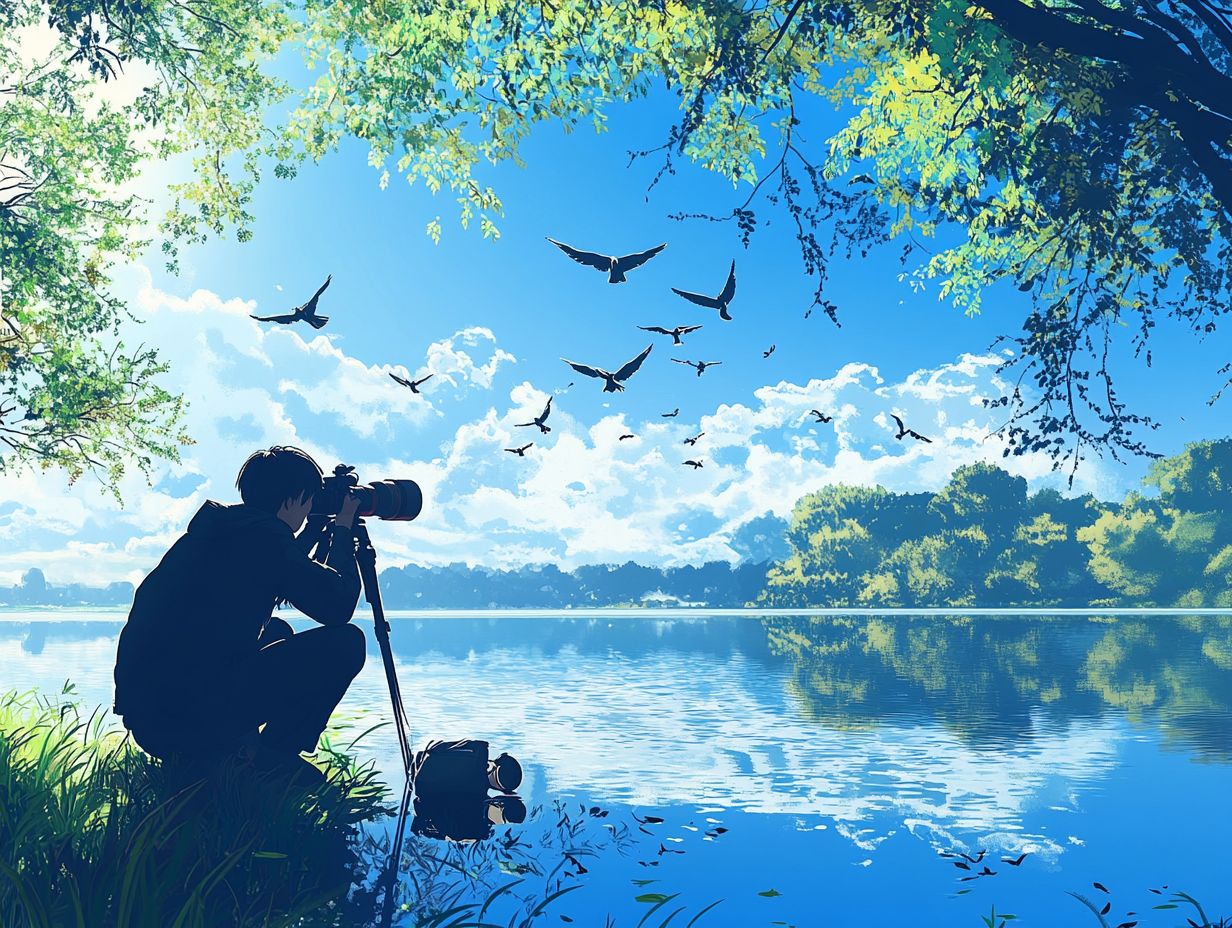
Photographing birds in flight requires key techniques. For those interested in capturing stunning images, consider these tips for photographing rare bird species: use a fast shutter speed, pan with the bird’s movement, and keep it in focus with continuous autofocus.
How can I capture sharp images of birds in flight?
To get sharp images, use a shutter speed of 1/1000 or higher. Keep your hand steady, and consider using a tripod or monopod.
What is the best time of day to photograph birds in flight?
The golden hour an hour after sunrise or before sunset is the best time. The soft light creates a stunning backdrop for your photos!
What type of camera and lens is best for photographing birds in flight?
A DSLR camera with a high continuous shooting speed is ideal. Pair it with a telephoto lens of at least 300mm for close-up shots.
How can I improve my composition when photographing birds in flight?
Capture birds in action, like when their wings are spread. Experiment with different angles and framing for dynamic shots!
What are some common mistakes to avoid when photographing birds in flight?
Avoid using a slow shutter speed and not tracking the bird’s movement. Always adjust your settings for varying light and respect the birds and their habitat.

